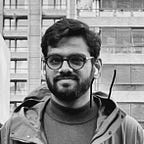Making Up Design Fiction: An Express Method
Trends forecasting, world-building, and artefact creation conducted live at the Primer21 conference as a part of Postcards from the Future
This article is a retrospective of the workshop that took place on the 10th of July 2021 at the Primer21 conference, a collection of thought experiments around future-casting, and a short selection of methods used in it.
Postcards from the Future is a crowdsourced and collaborative world-building and design fiction project. It started as a solo effort, and scaled up to an effort between me and some creative partners from around the world, later evolving into a crowdsourcing event series where I tease out the “postcards” through open discussions, and directional frameworks.
Each postcard is a vision from an alternate world that intends to ask questions about our own world and things we may take for granted.
I took this workshop as a chance to iterate upon the 18-month long project, and future-casting methods that have evolved over the span of the previous 31 postcards, and 5 crowdsourcing events. With the three-hour format, these methods and frameworks were presented in their longest and most elaborate form yet.
From ambiguous technology, climate change, social inequality, to the pandemic, our habits and ways in which we interact with our world have been forced to be reconsidered in recent times. Using techniques from strategic foresight, speculative design, and science fiction, the postcards build upon signals from around us extrapolated into intriguing scenarios. Their narrative-driven structure sets a stage for testing products, systems, and people’s relations with them. By dreaming of how things might be, we can get a better sense of how things should be, for them to be preferable to us.
Some Thought Experiments
Primer was a brilliant stage for me to crystallise and articulate some of my dormant thoughts about futures, and here they are:
What makes sci-fi plausible?
This line of thought is inspired from Yuval Noah Harari’s quote:
“Large numbers of strangers can cooperate successfully by believing in common myths. Any large-scale human cooperation — whether a modern state, a medieval church, an ancient city or an archaic tribe — is rooted in common myths that exist only in people’s collective imagination.”
― Yuval Noah Harari, Sapiens: A Brief History of Humankind
Answering “What Now” with “What if?”
Very often, we see disparate trends around us (social, economic, etc.) and wonder how they might affect the status quo, our businesses, and our very lives. We ask “What now?”
Trends allow us to future cast whilst keeping our feet grounded. Therefore, we could ask “What if?” in order to inform our answers to “What now?”
In other words, we could very well use speculation as a test bed for uncertain scenarios. This can then be used to inform our own behaviour, to craft principles that could help us as individuals and professionals to head into a preferred future, or indeed away from an unfavourable one.
If future-casting methods were used while technologies like Deepfakes were developed, might the technologies be inherently better prepared against their unforeseen consequences?
This thought experiment is used as follows to analyse Black Mirror’s “Nosedive” episode.
An Express Method for making up Design Fiction
When not conscious about following a process, our brains might still go through variations of divergent disruptive ideation, and convergent checks and balances. The following set of methods however, intentionally go through trend curation, world-building, and artefact creation deliberately, to produce design fiction from an alternate world.
One may want to indulge longer in many parts of this process for a more robust and well-studied output. Thus, this can be called an express method.
1. Curated Trend
Sandy helped curate trends for this workshop, and this was the shortlisted one. It is an aggregation of various news articles. This trend is later used to inspire world-building.
2. World-building tool
Extrapolating from the above trend, the participants worked on building a speculative world in a simple “complete the sentence” format. This builds upon my older “In a world where” framework. Whilst coming up with this framework, we focussed on the ideas of an individual against the system, making the uncanny feel mundane, and balancing elements of big-tech and governments against personal hopes and wishes.
3. Design Fiction Ideation
Once a world was established, we asked the participants to ideate design fiction artefacts in this world. This was built on principles of a product design style idea description / idea card.
The Output: Postcard from the Future 32
Finally, we took the three hour workshop in our stride, and produced this:
Foraging technology, foraging progress.
When all key resources required to build popular devices that signify “progress” sharply decline, might the world splinter between the technology haves and the have-nots?
If information is power, then what do those without the technology to access the information lose?
In such a world, might the have-nots forage for working bits of technology? Would they gain any edge over others around them thanks to their foraging?
Download the future-casting toolkit for your own use here.
Looking for more future-casting frameworks? Try these!
The session was conducted by Viraj Joshi and Sandeep “Sandy” Hoonjan. Big thanks to James Field, Vera Fearns and Maja Dika from the Primer21 / Design Futures Initiative team; and all the utterly creative participants of the session.
